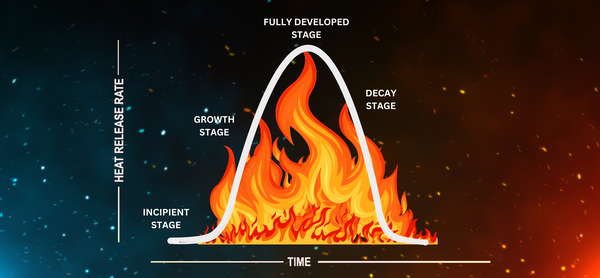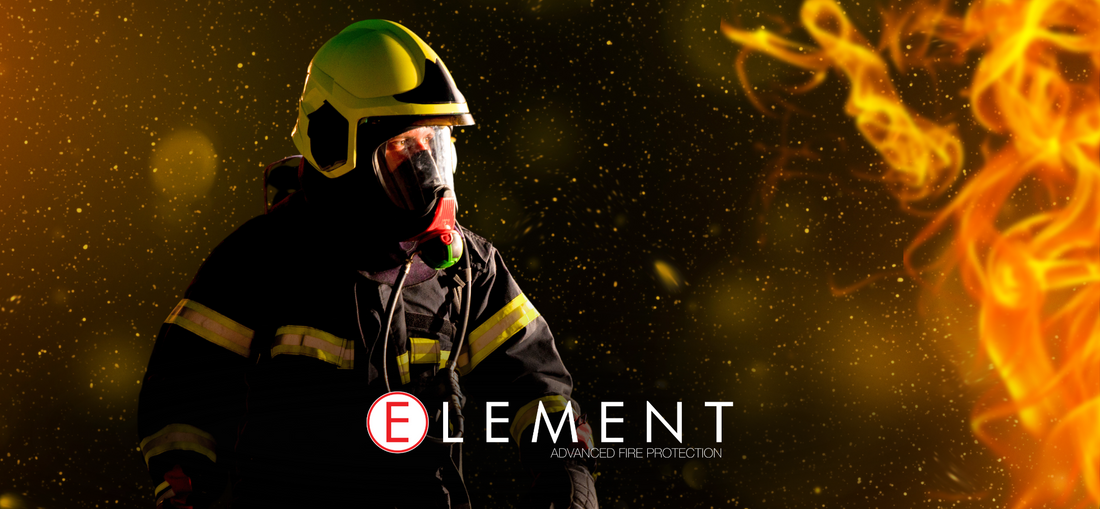Fires can start unexpectedly and escalate rapidly. It is essential to understand and be able to identify the different stages of a fire. This knowledge is not only crucial for effective fire suppression but also for ensuring your safety. Fires undergo four main stages: incipient, growth, fully developed, and decay. Each phase has distinct characteristics and dangers. Understanding them can help in deciding when it's time to call professional firefighters.
The Four Stages of a Fire

1. Incipient Stage
The first stage begins when heat, oxygen, and a fuel source (the fire triangle) combine and begin ignition. This is the initial phase of a fire and is often characterized by smoldering or a small flame that may ignite combustible materials nearby. During this stage, the fire is still relatively easy to extinguish with a handy fire extinguisher. Recognizing a fire in its incipient stage will prevent it from growing.
2. Growth Stage ← Call for Help
A fire enters the growth stage as it finds more available fuel and oxygen. This phase is marked by the fire increasing in size and intensity. Heat energy is released through convection and causes the fire to spread to nearby combustibles. The growth stage can lead to a flashover. This is when nearly all combustible materials in an area ignite simultaneously and contributes to creating a large fire. Personal fire suppression systems and extinguishing methods become less effective. It’s time to call the professionals. This is especially true in confined or enclosed spaces where heat and combustible gasses accumulate.
3. Fully Developed Stage
This is the stage when the fire has reached its maximum size and intensity. At this point it has consumed all available fuel and oxygen. It's characterized by large flames and thick, black smoke. The fully developed stage presents the greatest danger in terms of heat damage and structural collapse. This phase is the longest stage of a fire.
4. Decay Stage
The final stage occurs when there's a significant decrease in fuel or oxygen. This leads to a reduction in the fire's intensity. However, it doesn't mean the danger is over. Fires in the decay stage can still reignite if more fuel becomes available. This stage is also known for the dangers of backdraft and smoldering, which can suddenly escalate the fire again. Professional firefighters are skilled in handling these risks as they are trained to use ventilation and other methods to safely bring the fire to an end.
Getting a Fire Under Control
The first step in controlling a fire in its early stages is to quickly eliminate the heat source and get a hold of your Element fire extinguisher. Unlike traditional fire extinguishers that can be bulky and require periodic maintenance, Element is lightweight, maintenance-free, and capable of fighting all the major classes of fire (A, B, C & K). It can fight fires involving combustibles, flammable liquids, electrical equipment, and even Kitchen fires. Another huge advantage of Element is that it fights fires without leaving behind any mess! If you do not have an Element, use any other fire protection that you may have access to. This could include a traditional extinguisher, fire blanket or, in some cases of kitchen fires, baking soda. The goal is to get the fire subdued before it advances to the growth stage. No matter what fire suppression you use, it is important to know how to effectively operate it to fight fire in the most efficient way possible.
When to Call the Professionals
Understanding the four stages of fire helps in recognizing how and when a fire is escalating. This knowledge helps evaluate the level of danger and helps to identify the need for professional fire suppression efforts to protect individuals and structures from the devastating effects of fires.
If you are unable to get the fire under control within the incipient stage then you should immediately call for professional help. Waiting too long poses a significant risk to life and property. Firefighters are equipped with the necessary tools to safely and effectively combat fires in all stages.
Always remember, when in doubt, it's safer to evacuate the area and call for professional help to prevent potentially trapping yourself in a dangerous situation.
Every Second Counts
Getting a fire under control in its early stages is pivotal in preventing it from becoming larger and more dangerous. Element offers a significant advantage in easily fighting fires across all major fire classes without leaving behind any mess. Make sure you assess the situation carefully. Prioritize your safety and the safety of others by knowing when to engage and when to evacuate and seek professional assistance if necessary.

